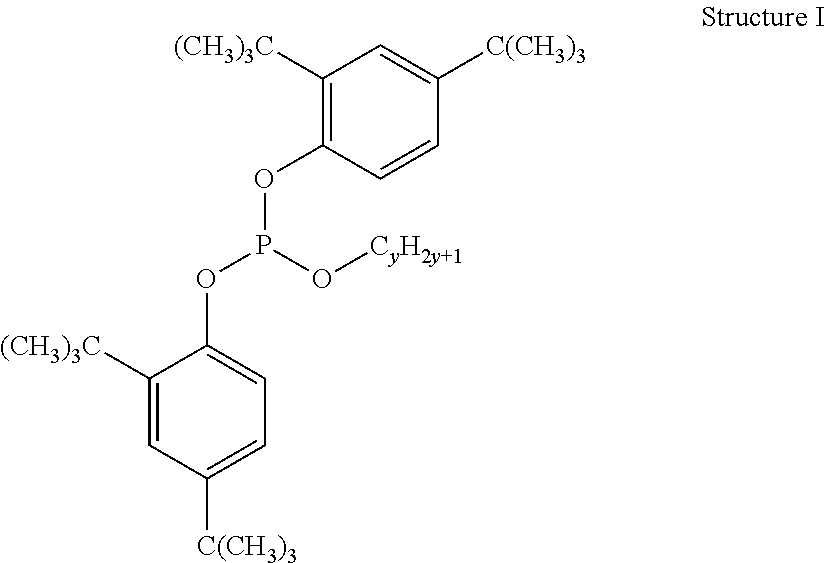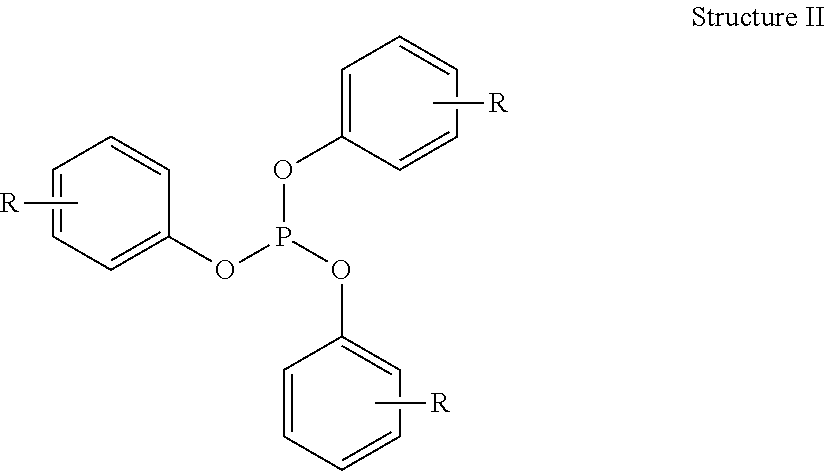Alkylphenol free - liquid polymeric phosphite polymer stabilizers
a polymer stabilizer and free liquid technology, applied in the field of alkylphenol free liquid polymeric phosphite polymer stabilizers, can solve the problems of plastic and rubber manufactures who have been reluctant to use tnpp in their formulation, and achieve the effects of low volatility, high molecule weight, and difficult extraction
- Summary
- Abstract
- Description
- Claims
- Application Information
AI Technical Summary
Benefits of technology
Problems solved by technology
Method used
Image
Examples
example # 1
Example #1
[0154]The apparatus in Example #1 was used. PPG 425 (55 g, 0.129 mol), triphenyl phosphite (45 g, 0.145 mol), Carbowax 350 (a mono-methylether polyethylene glycol with an average MW of 350), (63 g, 0.189 mol), and 0.8 grams of potassium hydroxide were added. The mixture was mixed well and heated to 160-162° C. under nitrogen and held at the temperature for 1 hour. The pressure was then gradually reduced to 0.3 mmHg and the temperature was increased to 170-172° C. over a course of 1 hour. The reaction contents were held at 170-172° C. under the vacuum for 2 hours at which point no more phenol was distilling out. The vacuum was then broken by nitrogen and the crude product was cooled to 50° C. The product was a clear, colorless liquid.
example # 2
Example #2
[0155]The apparatus in Example #1 was used. PPG 400 (95 g, 0.237 mol), triphenyl phosphite (73 g, 0.235 mol), a mixture of lauryl and myristyl alcohol with a hydroxyl number of about 280, (47 g, 0.235 mol), and 0.8 grams of potassium hydroxide were added. The mixture was mixed well and heated to 160-162° C. under nitrogen and held at the temperature for 1 hour. The pressure was then gradually reduced to 0.3 mmHg and the temperature was increased to 170-172° C. over a course of 1 hour. The reaction contents were held at 170-172° C. under the vacuum for 2 hours at which point no more phenol was distilling out. The vacuum was then broken by nitrogen and the crude product was cooled to 50° C. The product was a clear, colorless liquid.
example # 3
Example #3
[0156]The apparatus in Example #1 was used. PPG 400 (48 g, 0.12 mol), triphenyl phosphite (73 g, 0.235 mol), lauryl alcohol, (47 g, 0.235 mol), dipropylene glycol (16 g 0.12 mol) and 0.8 grams of potassium hydroxide were added. The mixture was mixed well and heated to 160-162° C. under nitrogen and held at the temperature for 1 hour. The pressure was then gradually reduced to 0.3 mmHg and the temperature was increased to 170-172° C. over a course of 1 hour. The reaction contents were held at 170-172° C. under the vacuum for 2 hours at which point no more phenol was distilling out. The vacuum was then broken by nitrogen and the crude product was cooled to 50° C. The product was a clear, colorless liquid.
PUM
| Property | Measurement | Unit |
|---|---|---|
| temperature | aaaaa | aaaaa |
| temperature | aaaaa | aaaaa |
| temperature | aaaaa | aaaaa |
Abstract
Description
Claims
Application Information
 Login to View More
Login to View More - R&D
- Intellectual Property
- Life Sciences
- Materials
- Tech Scout
- Unparalleled Data Quality
- Higher Quality Content
- 60% Fewer Hallucinations
Browse by: Latest US Patents, China's latest patents, Technical Efficacy Thesaurus, Application Domain, Technology Topic, Popular Technical Reports.
© 2025 PatSnap. All rights reserved.Legal|Privacy policy|Modern Slavery Act Transparency Statement|Sitemap|About US| Contact US: help@patsnap.com



